El Salvador << ehl SAL vuh `DAWR` >> is the smallest Central American country in area. But it ranks as the fourth largest country in population in Central America. Only Guatemala, Honduras, and Nicaragua have more people. El Salvador is a tropical land of rugged mountains, cone-shaped volcanoes, green valleys, and scenic lakes. The Pacific Ocean lies to its south, Guatemala to its northwest, and Honduras to its northeast.
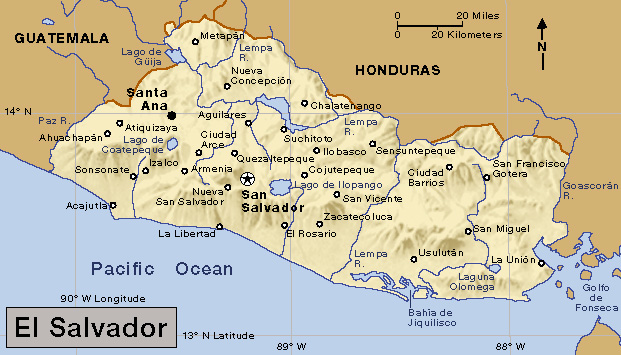
El Salvador is the most densely populated nation on the mainland of the Americas. It has about 9 times as many people per square mile as the United States, which has the largest population in the Americas.
The majority of people in El Salvador have both Indigenous (native) and Spanish ancestry. Most Salvadorans live in central El Salvador, the agricultural and industrial heartland. San Salvador, the country’s capital, lies in this region. Over half of El Salvador’s labor force works in service industries.
In 1525, Spanish soldiers led by Pedro de Alvarado conquered what is now El Salvador for Spain. Alvarado directed the founding of San Salvador that year. He named it for the Roman Catholic feast of San Salvador del Mundo (Holy Savior of the World), for which the entire country was later named.
Scarcity of fertile land has been a primary cause of turmoil and conflict in El Salvador. Beginning in the 1940’s, many Salvadorans moved from rural to urban areas as the supply of land became exhausted. About 300,000 other Salvadorans who wanted land settled illegally in sparsely populated areas of neighboring Honduras. The Honduran government forced many of these settlers out of Honduras, leading to a brief war in 1969.
During the 1980’s, a civil war between leftist rebels and the Salvadoran government caused many Salvadorans to leave the country. About 1 million people—one-fifth of the population—sought refuge in neighboring Central American nations and the United States. Hundreds of thousands more sought safety by moving to El Salvador’s cities. The war ended in 1992.
Government
Under El Salvador’s present Constitution, adopted in 1983, the country is a democratic republic with executive, legislative, and judicial branches of government. The president has executive power and is elected by the people for a five-year term. According to the Constitution, the president may not serve two consecutive terms. The legislative branch consists of the single-chamber Legislative Assembly. The Legislative Assembly has 60 members, who are elected by popular vote to three-year terms. The Supreme Court of Justice is the highest judicial authority.
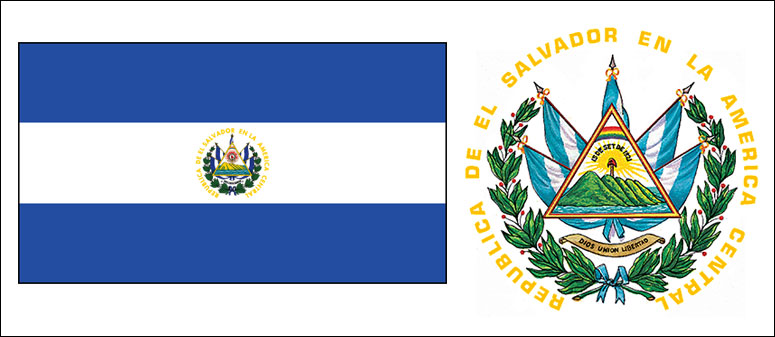
El Salvador is divided into 14 administrative departments, which are subdivided into municipios (townships). Each department has a governor appointed by the president. A council governs each municipio. The people elect their council members to three-year terms.
El Salvador has an army, a navy, and an air force. The country also has a paramilitary police force called the National Civilian Police.
People
Ancestry.
About 85 percent of all Salvadorans are mestizos—that is, people with both Indigenous and European ancestry. A little over 10 percent identify themselves as white, and about 1 percent are Indigenous.
The Indigenous people are mostly descended from the Pipil, the dominant group in the area when the Spanish conquerors arrived. Today, Indigenous Salvadorans live mainly in the southwestern highlands near the Guatemalan border. A small number of Salvadorans still speak the Nahuatl language of the Pipil.
Religion.
About half of Salvadorans are Roman Catholics. Evangelical Protestantism has grown rapidly since the 1980’s. Today, about 35 percent of the people are evangelical Protestants.
Housing
conditions vary greatly in El Salvador. In rural areas, some farmers own adobe houses with a dirt floor and thatched roof. Some poorer country people live in wattle houses, which have walls made of interwoven branches covered with mud. Many wealthy plantation owners live in spacious homes on their estates. However, these people are increasingly moving to the cities. 
In the cities, many poor families rent small apartments in crowded, decaying buildings. Homelessness is a serious problem. Natural disasters in the 1990’s and early 2000’s worsened El Salvador’s housing shortage. Houses in the large shantytowns around San Salvador often lack electric power, running water, and adequate sanitation. These slums contrast starkly with the luxurious, modern homes and landscaped gardens of wealthy residents. Middle-class city residents live in row houses (houses of similar design that share a common wall) or in comfortable apartments.
Food.
Most Salvadorans eat mainly beans, bread, corn, and rice. They also eat dairy products and meat when they can afford them. Pupusas (corn-meal tortillas stuffed with cheese, chopped meat, beans, and spices) are a popular snack. This Salvadoran specialty is sold at many roadside stands and is considered the national dish. El Salvador also imports some food from the United States, and American fast-food restaurants have become more common there. Despite improvements in health and nutrition since the end of the civil war in 1992, many people suffer from malnutrition.
Education.
Most of El Salvador’s adults can read and write. However, El Salvador’s public education system is inadequate. In many poor rural areas, children of elementary school age have less opportunity to attend school than do children in urban areas. Education is better in middle- and upper-class urban neighborhoods.
Students who complete nine years of basic (elementary) education may go to public secondary schools for two or three more years and then attend a university or trade school. El Salvador has a number of universities and technical schools that prepare young people for careers in agriculture, communications, engineering, and other fields. Few rural Salvadorans attend postsecondary institutions because these schools are concentrated in San Salvador.
Recreation.
Salvadorans love to spend their leisure time outdoors. Many people of all ages play soccer, the national sport, in neighborhood fields. Many families spend weekends at lake resorts or Pacific Ocean beaches. Los Chorros is a popular national park near Nueva San Salvador.
El Salvador’s most colorful religious festival celebrates the Feast of the Holy Savior of the World. It lasts from July 24 to August 6 and includes carnival rides, fireworks, dancing, and processions. Local religious festivals include the Fiestas Julias (July Festivals) in Santa Ana and the San Miguel Carnival in that city in November.
Social problems
in El Salvador include violent crime and widespread poverty. Government officials blame much of the violence on gangs that extend beyond El Salvador’s borders, such as Mara Salvatrucha (also called MS-13), which originated in Los Angeles among refugees of El Salvador’s civil war. Poverty has caused many workers to leave El Salvador in search of jobs, despite overall economic expansion in the country since the mid-1990’s. Much of El Salvador’s rural population lacks access to basic health services, and urban slums continue to grow.
The land
El Salvador has three main land regions These regions are, from south to north, (1) the Coastal Lowlands, (2) the Central Region, and (3) the Interior Highlands.
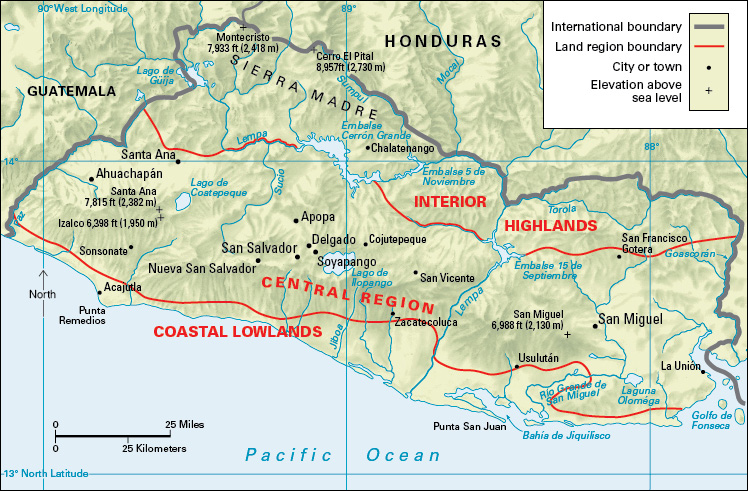
The Coastal Lowlands
consist of a narrow, fertile plain along the Pacific shore. They extend 10 to 20 miles (16 to 32 kilometers) inland. Large areas of the land have been developed for farming. A number of factories and a fishing industry operate near Acajutla, the leading port.
The Central Region
is the heartland of El Salvador. Most of the people live there, many of them in such large cities as San Salvador and Santa Ana. The region also has most of the country’s industry and fertile farmland. The Coastal Range, a band of rugged mountains and inactive volcanoes, forms the region’s southern border. Coffee plantations and cattle ranches sprawl among oak and pine forests on the range’s lower slopes. North of the Coastal Range is a broad plateau of gently rolling land. The plateau’s volcanic soil and green pastures make it El Salvador’s chief agricultural region. 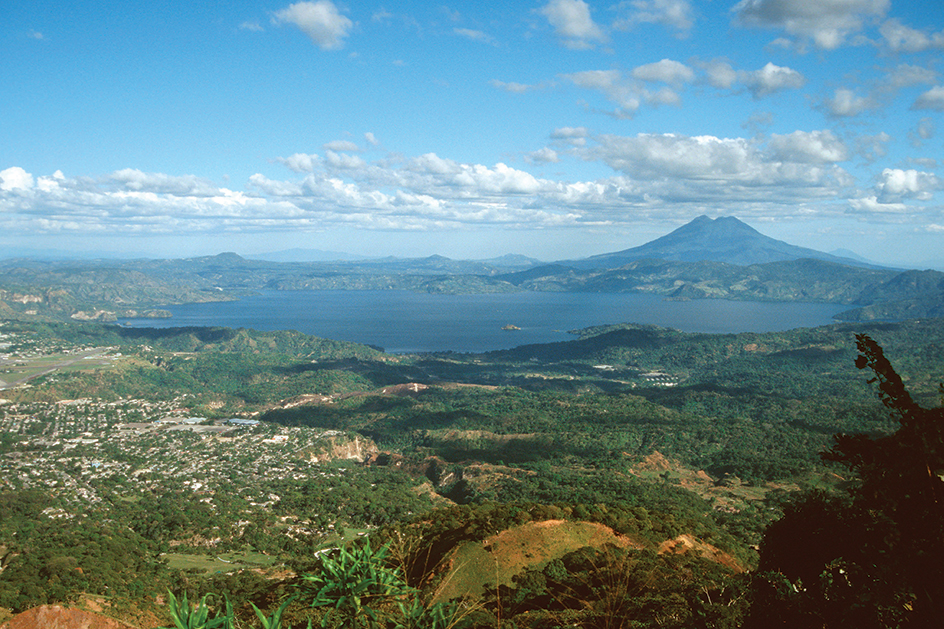
The Interior Highlands
in northern El Salvador rank as the most thinly populated region of the country. The Sierra Madre, a low mountain range of hardened lava, rocks, and volcanic ash, covers most of the highlands. El Salvador’s largest river, the Lempa, rises in the Sierra Madre and flows 200 miles (320 kilometers) to the Pacific. A few small farms and ranches are in the area.
Climate
El Salvador has a tropical climate that varies slightly from area to area because of differences in altitude. Average year round temperatures range from 80 °F (27 °C) in Acajutla along the coast to 73 °F (23 °C) in Santa Ana in the mountains.
Showers fall every afternoon in the rainy season, which lasts from May to October. Yearly rainfall ranges from 85 inches (216 centimeters) along the coast to less than 60 inches (150 centimeters) in the northwest.
Economy
For many years, El Salvador’s economy depended mainly on agriculture. Today, the country has a more diverse economy. Both manufacturing and service industries are growing in importance. Remittances (money sent home) from Salvadorans working abroad are another important source of national income.
Cropland and pastures cover three-fourths of the country, and many of the country’s workers are farmers or ranchers. Livestock and livestock products, including beef and dairy cattle, hogs, and poultry products, account for much of the country’s agricultural income. Many of the farmers own small farms. They cultivate beans, corn, rice, and other crops for their families and for local markets. Other farmers work on large commercial plantations called fincas, which raise coffee and sugar cane. Coffee, one of El Salvador’s leading crops, is raised throughout the country, but it grows best at the high elevations near Santa Ana. Sugar cane thrives in the warm, humid lowlands along the coast. 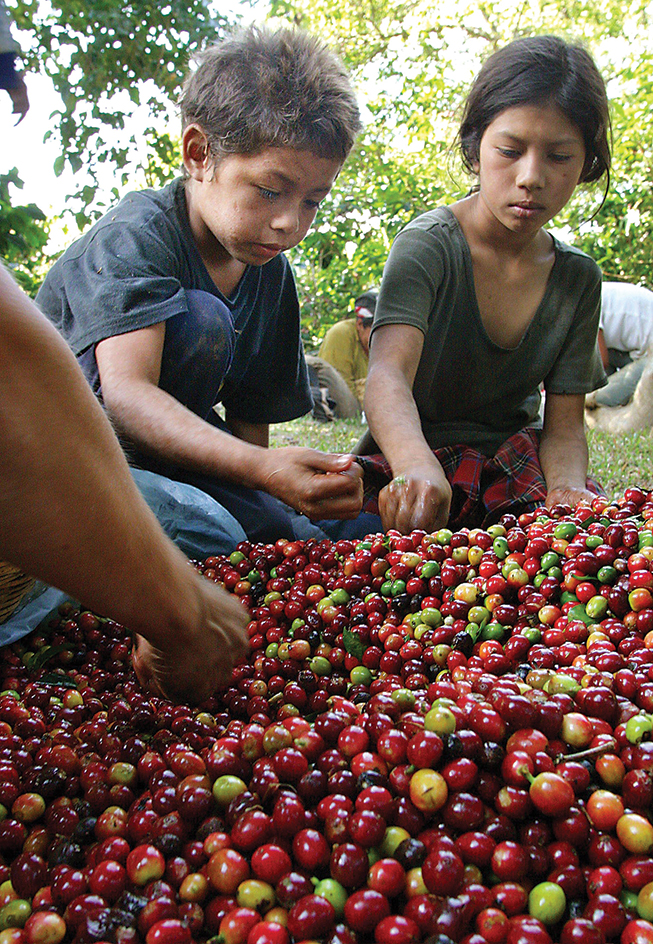
The federal government has encouraged the creation of new industries to lessen the nation’s dependence on agriculture. Its efforts have helped expand industrialization, and manufacturing is now one of the leading sectors in El Salvador’s economy. The leading industries produce chemicals, clothing, foods and beverages, medicine, petroleum products, and textiles.
Over half of El Salvador’s labor force is employed in service industries. Hotels, restaurants, and shops benefit from the increasing number of tourists from Guatemala, Honduras, the United States, and other countries.
El Salvador exports clothing, coffee, medicine, and sugar. Chief imports include chemicals, food, machinery, and petroleum. Costa Rica, Guatemala, Honduras, Mexico, Nicaragua, and the United States are among El Salvador’s main trading partners. El Salvador belongs to the Central American Common Market, an economic union that was formed to stimulate trade among its members.
El Salvador has a good network of highways. The Pan American Highway spans the country from east to west. However, few Salvadorans own an automobile. Most people rely on public transportation. El Salvador has major ports at Acajutla and Puerto Cutuco. An international airport is at Compalapa, near San Salvador.
History
What is now El Salvador supported Indigenous cultures for at least several thousand years before Europeans took control of the area in the 1500’s. The ruins of huge limestone pyramids built by Maya people between A.D. 100 and 1000 still stand in western El Salvador. By the A.D. 900’s, groups of people who spoke the Nahua language had begun to migrate into the region from what is now Mexico. These Pipil people seized control of the lands west of the Lempa River during the 1000’s. They built cities, raised crops, and were skillful weavers. Groups that spoke a language called Lenca lived in what is now eastern El Salvador.
Colonial period.
In 1524, Spanish soldiers led by the conquistador (conqueror) Pedro de Alvarado invaded El Salvador. The Spaniards defeated the Pipil and their allies in several years of brutal warfare. El Salvador remained a Spanish colony for about 300 years. The colony had little mineral wealth and few exports. As a result, it attracted fewer settlers than did Spain’s other colonies in the Americas. The majority of the colonists and the Indigenous people farmed the land and raised cattle.
Independence.
In 1821, El Salvador and Spain’s other Central American colonies broke away from Spanish rule. In 1823, all but Panama joined together in a federation (union) called the United Provinces of Central America. José Matías Delgado, a Salvadoran Catholic priest, led El Salvador’s revolt against Spain and headed the convention that drafted the federation’s constitution. The union began to collapse in 1838. El Salvador withdrew in 1840. In 1841, El Salvador formally declared its independence from the federation.
Political violence shook El Salvador during the rest of the 1800’s. Five presidents were overthrown by force, and two others were executed. Strong dictators in neighboring countries, including Rafael Carrera in Guatemala, controlled several weak Salvadoran presidents.
The 1900’s.
The government became more stable in the late 1800’s. From 1913 to 1931, all of El Salvador’s presidents were wealthy coffee planters. National prosperity centered around coffee exports, which provided a large majority of government revenue. During this period, rich Salvadorans who made up a small part of the population owned most of the choice farmland. Most rural people had poor farmland or none at all.
In 1931, General Maximiliano Hernández Martínez seized the government. He ruled as a dictator for 12 years. He built many public schools, expanded social service programs, and supported labor reform. A revolution led by landowners, members of the middle class, professionals, and university students deposed Hernández Martínez in 1944. However, military governments continued to rule El Salvador through the 1970’s.
In the 1940’s, large numbers of landless Salvadoran farmers began to settle in the sparsely populated countryside across the border in Honduras. In 1969, Honduran land reform laws forced many of these farmers to give up their land and leave Honduras. The farmers’ return to El Salvador increased population pressures and land scarcity there. Tensions created by the land reform laws and by a long-standing border dispute between El Salvador and Honduras erupted in a four-day war. The Organization of American States arranged a cease-fire, but many Salvadoran peasants had lost their land.
In the late 1970’s, widespread protests broke out in El Salvador in response to economic problems and fraudulent presidential elections in 1972 and 1977. The protesters demanded that the government provide land and jobs for the poor. A few vocal members of the Roman Catholic clergy supported the protesters. Some opponents of the government kidnapped business and political leaders for ransom to raise money for their cause.
In 1979, army officers removed the president, General Carlos Humberto Romero, from office. They replaced him with a junta (small group that rules by decree). Meanwhile, fighting between Salvadoran military forces and leftist rebels was growing. The assassination of Archbishop Oscar Arnulfo Romero of San Salvador in March 1980 led to an escalation of the fighting and touched off widespread rioting. The archbishop had been an outspoken critic of the government. Several leftist groups formed the Farabundo Martí National Liberation Front (FMLN) in late 1980.
With the level of violence in El Salvador increasing, the junta appointed José Napoleón Duarte president in December 1980. Duarte, a civilian and a member of the Christian Democratic Party, immediately began a number of reforms, including a major program to distribute land to poor people. However, the violence continued. During the 1980’s, the United States provided El Salvador’s government with large-scale financial and military support to help fight the leftist rebels.
In 1983, an elected assembly completed a new constitution that restored democratic elections in El Salvador. In 1984, the voters elected Duarte president. However, Duarte was unable to negotiate a cease-fire and end the civil war with the FMLN. In 1986, an earthquake struck San Salvador. It caused more than 1,000 deaths and left many people homeless.
In 1989, Salvadoran voters elected Alfredo Cristiani of the right-wing Nationalist Republican Alliance (ARENA) president. A new president from the ARENA party won each successive election until 2009.
Also in 1989, FMLN forces staged a nationwide offensive that resulted in the worst fighting of the civil war up to that time. Civilian casualties were heavy. On Jan. 16, 1992, the government and the FMLN signed a peace agreement. The war officially ended on December 15, with the disbanding of FMLN forces and a reduction in the Salvadoran armed forces. About 75,000 people had died during the war, and more than 1 million had fled from their homes.
The United Nations Truth Commission determined that most serious acts of violence committed during the war had been carried out by Salvadoran troops, paramilitary forces, and right-wing death squads. The governments of the 1990’s argued that the report had exaggerated the level of state violence against civilians.
The 2000’s.
Earthquakes struck El Salvador in 2001, killing about 1,200 people and leaving more than 1 million homeless. In 2004, Salvadorans elected Elías Antonio (Tony) Saca president. Also in 2004, El Salvador ratified the Dominican Republic-Central America-United States Free Trade Agreement (CAFTA-DR). This pact, which took effect in El Salvador in 2006, was designed to reduce trade barriers among the participating countries.
In 2009, heavy rains caused flooding and landslides in central El Salvador. The storm killed more than 100 people, left more than 10,000 homeless, and devastated crops. Also in 2009, Salvadorans elected Mauricio Funes of the leftist FMLN as president, ending nearly two decades in power for the conservative ARENA party. Vice President Salvador Sánchez Cerén succeeded Funes as president in 2014. In 2017, El Salvador became the first country to ban metal mining nationwide, to protect the environment and natural resources.
In 2019, former San Salvador mayor Nayib Bukele was elected as El Salvador’s president. Bukele’s government took steps that undermined the independence of the judiciary and raised concerns about civil liberties. In 2022, the government enacted severe measures against a surge in gang violence. During a state of emergency that lasted more than two years, security forces arrested tens of thousands of suspects, and serious human rights abuses were reported.
In December 2023, Bukele began a six-month leave of absence. Despite a constitutional ban on consecutive presidential terms, the Supreme Court had ruled that such a leave would qualify Bukele for reelection. Claudia Juana Rodríguez de Guevara, Bukele’s private secretary, was appointed as acting president. Bukele was reelected as president in February 2024 and resumed serving as president in June.
